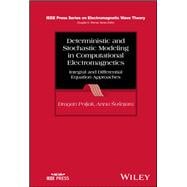Help protect your network with this important reference work on cyber security
Deterministic computational models are those for which all inputs are precisely known, whereas stochastic modeling reflects uncertainty or randomness in one or more of the data inputs. Many problems in computational engineering therefore require both deterministic and stochastic modeling to be used in parallel, allowing for different degrees of confidence and incorporating datasets of different kinds. In particular, non-intrusive stochastic methods can be easily combined with widely-used deterministic approaches, enabling this more robust form of data analysis to be applied to a range of computational challenges.
Deterministic and Stochastic Modeling in Computational Electromagnetics provides a rare treatment of parallel deterministic-stochastic computational modeling and its beneficial applications. Unlike other works of its kind, which generally treat deterministic and stochastic modeling in isolation from one another, it aims to demonstrate the usefulness of a combined approach and present particular use-cases in which such an approach is clearly required. It offers a non-intrusive stochastic approach which can be incorporated with minimal effort into virtually all existing computational models.
Readers will also find:
- A range of specific examples demonstrating the efficiency of deterministic-stochastic modeling
- Computational examples of successful applications including ground penetrating radars (GPR), radiation from 5G systems, transcranial magnetic and electric stimulation (TMS and TES), and more
- Introduction to fundamental principles in field theory to ground the discussion of computational modeling
Deterministic and Stochastic Modeling in Computational Electromagnetics is a valuable reference for researchers, including graduate and undergraduate students, in computational electromagnetics, as well as to multidisciplinary researchers, engineers, physicists, and mathematicians.









